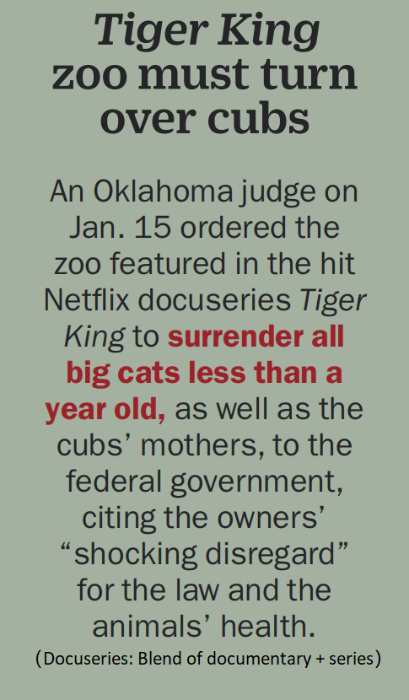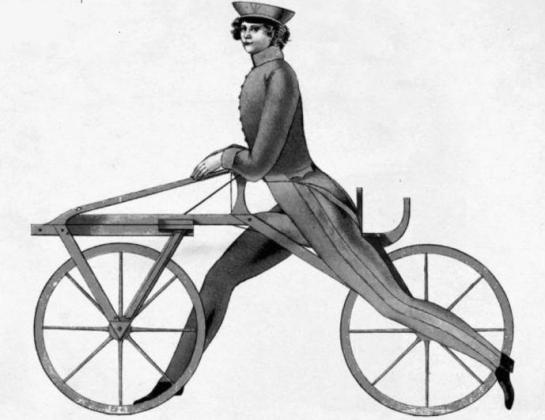阅读赛项考查选手的阅读基本功、知识储备、跨文化能力、思辨能力、创新能力等。赛题融入习近平新时代中国特色社会主义思想和中华优秀传统文化,展现当代中国的发展成就和经验;同时兼具全球视野,展现多元文化,引导选手胸怀天下,为推动国际交流合作打好基础。阅读文本贴近真实阅读场景,激发选手阅读兴趣,增强选手阅读体验,引导选手关注和分析实际问题。
赛题说明:
校赛(全国统一线上初赛)题目包含Read and Know,Read and Reason,Read and Question三个模块。
省赛和国赛题目包含Read and Know,Read and Reason,Read and Question,Read and Create四个模块。
Read and Know 读以明己
客观题,考查选手对习近平新时代中国特色社会主义思想重要论述、中华思想文化术语、名人名言等的阅读积累及对其他各类短篇材料的信息获取、理解与分析能力。
本模块在校赛阶段为15题,每题2分;在省赛和国赛阶段为16题,每题1分。建议作答时间20分钟。
Read and Reason 读以察世
客观题,考查选手对不同题材、不同体裁的中短篇文本的信息获取、判断及逻辑推理能力。
本模块在校赛阶段为10题,每题3分;在省赛和国赛阶段为12题,每题2分。建议作答时间30分钟。
Read and Question 读以启思
客观题,考查选手对同主题下多篇较长文本的信息获取、对比、分析及整合能力。一般为两个主题,每个主题下包含2—3篇不同角度和语言特点的论述性阅读材料。
本模块为10题,校赛阶段每题4分,省赛和国赛阶段每题3分。建议作答时间40分钟。
Read and Create 读以言志
主观题,话题选自2023阅读赛项官方指定书目,考查选手对文本的阅读理解、提炼总结、评价论述能力,思辨能力及创新能力。
本模块仅在省赛和国赛阶段考查,共30分,建议作答时间30分钟。评分标准如下:
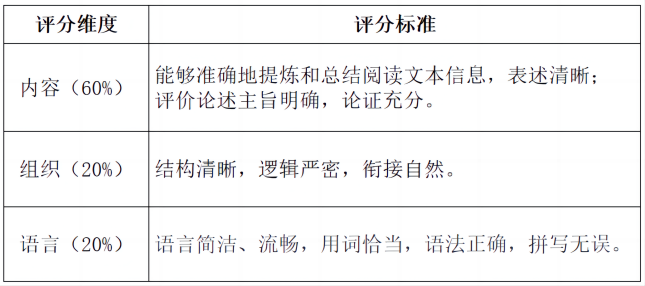
注:此套样题前三模块为校赛难度,最后的主观题模块为省赛难度,文末附有参考答案。
Part I Read and Know (30 marks) (20 MINS)
There are short texts of various kinds in this part. Read the directions and answer the questions.
Question 1
Directions: Read the text and answer the question.
The Chase Diamond Reserve is a great credit card for people who expect to be on the road again in the second half of 2023 and into 2024. Despite a high annual fee, the card offers luxury travel perks such as airport lounge access and strong travel insurance protections, along with a number of statement credits to help offset its cost.
1. Where is the text most probably taken from?
A. An airport notice.
B. A user review.
C. An advertisement.
D. A product instruction.
Question 2
Directions: Read the brief news in 2021 and answer the question.
2. What do we know from the news?
A. The zoo was built specifically for filming the documentary series Tiger King.
B. Tiger King was an extremely successful documentary series about animal rights.
C. A federal judge found the cat zoo owner guilty of violating the animal welfare law.
D. All the big cats in the zoo were ordered to be transferred to the federal government.
Question 3
Directions: Read the text and answer the question.
As the saying goes: if your granny doesn’t recognise what’s in it, it’s probably not real food. Yet half the food we take home is made in factories from a list of ingredients and additives as long as your arm, most of which never found a place in any grandparents’ kitchen cupboard—and wouldn’t in yours or mine today.
The UK is a nation of ultra-processed-food eaters. Our lives have become too fast-paced to cook from scratch and our taste buds now crave the sweet and salty flavors that ultra-processed foods deliver. Our bread is fluffy and sticks to the teeth like candy floss. Our yogurts are super-sweet and creamy. We have ready meals that are shelf-stable (long life without refrigeration), which we can prise open, heat, eat and go.
3. What is the author’s attitude towards ultra-processed food?
A. Critical B. Impartial C. Defensive D. Mixed
Question 4
Directions: Read the text and answer the question.
In a bid to step up economic and social progress, it is imperative that all sectors work in unison. . The public and private sectors of the economy should be mutually reinforcing and beneficial; there is no need for conflict or strife.
—Xi Jinping: The Governance of China II
4. Which of the following sentences best fits in the blank?
A. A thing is yet to be done until it is done.
B. Clear waters and green mountains are invaluable assets.
C. The flame leaps high when everybody adds wood to a fire.
D. Distance tests a horse’s strength, and time reveals a person’s integrity.
Questions 5-6
Directions: Read the text and answer the questions.
As if a declining population wasn’t bad enough, a rare species of bird in Australia has now forgotten how to sing. The falling numbers of the Regent Honeyeater mean that fewer adults are around to pass on to young males the melodies they need to know to attract a mate—a problem that can only exacerbate the current situation. Some hope lies in the fact that honeyeaters are famously good mimics, and so scientists are investigating if they can be retaught their vocal skills by artificial means in a lab. And perhaps, we cheekily suggest, our feathered friends could be taught some new tunes at the same time? A bit of William Byrd would be an obvious place to start ..
5. What does the word exacerbate probably mean?
A. settle
B. reduce
C. control
D. worsen
6. What is the best title for the text?
A. Songful Dismissal Proves a Worry for a Male Bird
B. Regent Honeyeaters Are Being Pushed to the Brink
C. A New Application of Artificial Intelligence in Music
D. Significance of Artificial Environment in Birds' Singing
Questions 7-8
Directions: Read the text and answer the questions.
One thing to remember in our age of instant gratification is that friends aren’t found; instead, friends are made—crafted, really—over time. It takes 6 to 8 conversations before someone considers us a friend. We wish we could walk into a party, instantly connect, and walk out arm-in-arm with a new BFF (Best Friend Forever), but really it’s an incremental process. The good news is that the bar to start is low. It’s been shown again and again that, as long as we are mutually kind to each other, we become friends with whomever we see most often. 8 and repetition are key. So put yourself in situations where you see the same faces again and again: a dog park at the same time each morning, a weekly writer’s workshop, or a co-working space.
7. What factor is essential to friend-making according to the text?
A. Mutual affection.
B. Frequent contact.
C. Instant connection.
D. Face-to-face communication.
8. What is the missing word probably?
A. Inclusion
B. Attraction
C. Proximity
D. Diversity
Questions 9-11
Directions: Match the explanations with the concepts in Chinese thought and culture. Please note there are two extra options.
9. Authors are encouraged to discard mediocre, derivative ideas when writing and their essays should be written in an innovative way. Stereotyped wording and argument and rigid convention should be abandoned.
10. What one talks or writes about should have a sound basis; the language and words he uses should fit the actual context. In doing anything, one should preserve until the goal is met and must never give up halfway.
11. The way to ensure proper governance and operation of a country is to create harmonious relationships among people and let them speak their minds without fear so those in power can benefit from their various opinions.
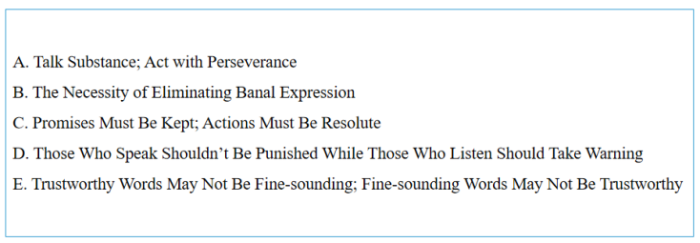
(From Everyday Wisdom: 365 Concepts in Chinese Thought and Culture)
Questions 12-15
Directions: Read the chart and answer the questions.
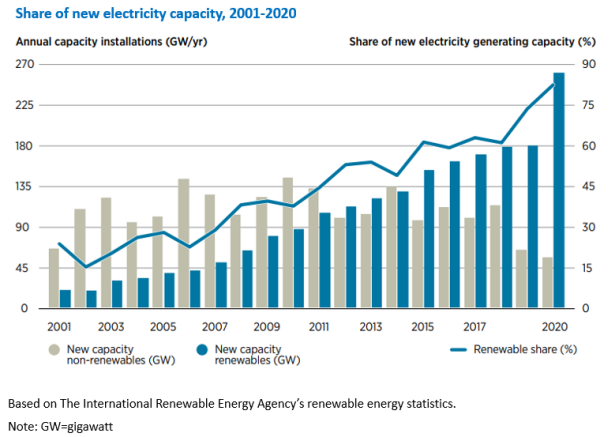
Decide whether the following statements are True or False according to the chart.
12. The chart reflects not only the steady and increasing growth in the use of renewables but also the continuous decline in the growth of non-renewable capacity.
True ( ) False ( )
13. The renewable generation capacity in 2020 was more than six times the non-renewable generation capacity.
True ( ) False ( )
14. Renewable generation capacity has accounted for more than half of total electricity generating capacity since 2015.
True ( ) False ( )
15. The renewable generation capacity has been greater than the non-renewable generation capacity since 2012.
True ( ) False ( )
Part II Read and Reason (30 marks) (30 MINS)
There are several texts on different subjects in this part. Read the directions and answer the questions.
Question 16
Directions: Read the text and answer the question.
We live in an age of unprecedented human mastery—over birth and death, body and mind, nature and human nature. // ①If we can dream about a new age of genetic medicine, we can also shudder at a new age of weapons of mass destruction. ②But our gratitude for the benefits of progress increasingly mixes with concern about the meaning and consequences of our newfound powers. ③In every realm of life, science and technology have brought remarkable advances and improvements: We are healthier, wealthier, and more comfortable than ever before. // As we welcome longer lives, we wonder if we will still value human life as we should.
16. What is the right order of the numbered sentences?
(Type the answer in the blank without any spaces or punctuation marks, e.g., 123)
Question 17
Directions: Look at the following picture and answer the question.

17. Which of the following logical fallacies does the advertisement use?
A. Appeal to nature: stating that natural things are either good or better than synthetic ones.
B. Ambiguity: using a double-meaning or an unclear description to mislead or misrepresent the truth.
C. Hasty generalization: making an argument or a statement without sufficient evidence to support it.
D. Bandwagon: trying to persuade people on the fence to join the larger group and reduce their risk of being isolated and alone.
Question 18
Directions: Read the conversation and answer the question.
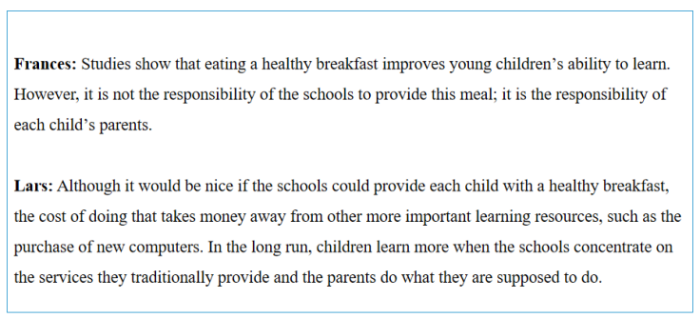
18. In what way does Lars’s comment relate to Frances’s?
A. It states the logical outcome of Frances’s views.
B. It weakens Frances’s argument by changing the focus of the discussion.
C. It strengthens Frances’s argument by providing support for her premise.
D. It cannot be true if Frances’s assertion about parental responsibility is true.
Questions 19-20
Directions: Read the text and answer the questions.
The eruption in April 1815 of Mount Tambora, a volcano in what is now Indonesia, was one of the largest in recorded history. A vast plume of dust and ash spread around the world, blocking out the sun and reducing global temperatures. In China, the cold weather killed trees, crops and water buffalo. In North America a “dry fog” reddened the sun and there was summer snowfall in New York. Riots and looting broke out in Europe as harvests failed. Food prices soared and tens of thousands of people died from famine and disease. Horses starved or were slaughtered, as the high price of oats forced people to choose whether to feed their animals or themselves.
This last predicament prompted Karl von Drais, a German inventor, to devise a personal-transport machine to replace the horse: a two-wheeled wooden contraption which he called the Laufmaschine (literally, “running machine”). Sitting on a saddle, Drais propelled it by planting his feet on the ground and pushing every few metres, while steering it using a tiller. A demonstration ride, in which he travelled 40 miles in four hours, showed that it was as fast as a trotting horse, and could be powered by its rider without much effort. The tricky part was keeping it balanced while gliding along, which took some practice.
Drais’ invention didn’t replace the horse: The weather returned to normal, leading to a bumper harvest in 1817. Even so, enthusiasts continued to improve on his design. The crucial addition of pedals occurred in France in the 1860s. Other refinements included better brakes, a steel frame, lightweight metal wheels and a chain to drive them. By the late 1880s, these elements had been combined into a recognisably modern design: the bicycle.
An invention prompted by the challenges of a long-forgotten global crisis thus ended up spreading around the world and becoming part of everyday life. Who would have guessed, after all, that a volcano would give rise to the bicycle?
19. What was the difficulty in riding Drais’ bicycle?
A. How to steer it using a tiller.
B. How to propel it using feet.
C. How to keep it in balance.
D. How to drive it faster.
20. What is the best title for this text?
A. How Bicycles Got Refined Step by Step
B. Why Global Crises Are the Mother of Invention
C. The Real Value Behind the Invention of Bicycles
D. The Unexpected Consequence of a Volcano Eruption
Questions 21-22
Directions: Read the text and answer the questions.
Do you hear what I hear? More than just a memorable holiday song, it’s a question that got people talking—talking about Yanny vs. Laurel.
Shortly after a viral audio recording left people wondering why some heard “Yanny” and others clearly heard “Laurel,” we learned that what you heard has less to do with your auditory system and more to do with the brain.
And the saga continues: A new Northwestern University (NU) study has found that bilingual and monolingual people listening to the same person speaking can hear two completely different sounds. The research shows that one’s language experience affects even the most basic cognitive processes, according to Viorica Marian, a professor of communication sciences and disorders and psychology at Northwestern University.
“With Yanny and Laurel, our brain interprets the sound differently depending on how the neurons fire in our brain and based on the history of our linguistic experiences,” Marian said. “We classify the sound waves that come into our ear into linguistic categories that we are familiar with, so we hear a very categorical sound—what happens is the brain interprets the input that comes to us from our senses and transforms it into our perceived reality.”
Your previous auditory and linguistic experience influences how you perceive the sound around you—the world around you—she said. Case in point: If you find accents easy to understand, you may have taken music lessons at some point in your life. Marian said learning the language of music can change the way your brain processes sound.
And if you thought Yanny and Laurel were perplexing, scope out the McGurk effect—wherein what you see affects what you hear. For example, when people hear a speech sound (e.g., “ba”) that conflicts with what they see (e.g. “ga”), they will often perceive a completely different sound (e.g. “da”).
The NU study found that bilinguals are more likely to experience the McGurk effect than monolinguals, because their exposure to another language allows their brain to interpret auditory and visual modalities differently.
“I think that’s maybe why the Yanny and Laurel thing is so fascinating to people because it’s the same sound, but people hear it so differently, and it’s an illustration of what happens in every aspect of our lives without even realizing it,” Marian said.
The Yanny/Laurel uproar began after the release of Marian’s study, but she said it and the bilingual/McGurk effect cases are mutually informative.
“We don’t see with our eyes; we don’t hear with our ears—we perceive with our brain. Our brain interprets the reality of our own lives,” Marian said. “The brain takes the input from the ears, takes the input from the eyes and combines them in an interesting way. It’s fascinating.”
21. What may lead to the Yanny and Laurel phenomenon?
A.Your auditory system.
B.Your musical talent.
C.Your brain structure.
D.Your linguistic experiences.
22. Why does the writer mention the McGurk effect?
A.It is also a confusing perceptual phenomenon.
B.It has a mechanism similar to Yanny and Laurel.
C.It has also aroused people’s extensive concern.
D.It is intimately associated with Yanny and Laurel.
Questions 23-25
Directions: Read the text and answer the questions.
Chinese company Space Transportation wants to take a jab at the growing space tourism market with a winged rocket capable of suborbital travel. The reusable space plane could take wealthy tourists to the edge of space and then land them on the other side of the world in no time. A trip from Beijing to New York would only take an hour.
Space Transportation was founded in 2018 and last August it managed to raise $46 million to develop its flagship supersonic spaceplane. Although details are still sparse, a video presentation on the company’s website shows passengers boarding a vertical plane attached to a glider wing with two boosters. Once it reaches a high altitude in the stratosphere, the airplane detaches from the auxiliary power, with the wing and boosters landing back on the launch pad on their own. The airplane, now in suborbital space, proceeds to its destination, back at the launch site after passengers experience a brief stint of weightlessness or in a different destination altogether, virtually anywhere in the world. Touchdown is done vertically on three legs deployed from the rear, according to Space.com.
The developers behind the project seem pretty serious about it. So far, they’ve made 10 flight tests for the self-landing booster rockets, the last of which was done in collaboration with a combustion research lab from Tsinghua University.
In many ways, Space Transportation sounds like the Chinese version of Virgin Galactic and, to a lesser degree, SpaceX. In the summer of 2021, Virgin CEO Sir Richard Branson made headlines after he went on an 11-minute suborbital flight, reaching 55 miles (88 km) above the Earth’s surface. Just a week later, fellow billionaire Jeff Bezos made it past the Kármán Line, the internationally-recognized boundary of space, at nearly 62 miles (100 km) above the Earth’s surface, aboard a capsule launched by Blue Origin’s New Shepard reusable rocket.
Global space tourism is projected to reach just $1.7 billion by 2027, according to a report published in 2021. Virgin Galactic has hundreds of reservations for tickets on future flights, sold between $200,000 and $250,000 each. No reservation data has been made public by Blue Origin, but we can presume they’ll soon start making more commercial space tourism flights.
However, neither Virgin Galactic nor Blue Origin seems to be interested in point-to-point travel. In addition to potential space tourism flights, Space Transportation’s vehicle also doubles as a supersonic plane capable of traveling at more than 2,600 mph. SpaceX had plans for a similar concept when it announced its “Earth to Earth” project in 2017, which repurposes its Big Falcon Rocket originally meant to carry passengers to Mars. But Elon Musk’s company hasn’t released any details about this city-to-city passenger transport since then, which may mean it could have been scrapped entirely.
Perhaps SpaceX found city-to-city supersonic travel financially unfeasible, but Space Transportation doesn’t seem deterred. It is planning ground tests by 2023, the first flight by 2024, and a crewed mission by 2025. Looking farther into the future, the Chinese startup dreams of testing an orbital crew space vehicle, the kind that SpaceX uses to ferry crew and cargo to the International Space Station, by 2030.
23. Why does Space Transportation develop its flagship supersonic spaceplane?
A. To realize the reuse of space planes.
B. To fulfill the supersonic space travel plan.
C. To solve the problems of self-landing rockets.
D. To compete with Virgin Galactic, Blue Origin and SpaceX.
24. What can be learned about Virgin Galactic and Blue Origin?
A. Both have launched suborbital flights.
B. Both aim high at sending passengers to Mars.
C. Both have made a fortune from space tourism.
D. Both are interested in the exploration of outer space.
25. What is the purpose of the text?
A. To encourage wealthy people to reserve space flight tickets.
B. To show the fierce competition in the global space tourism market.
C. To disclose the technological bottleneck of self-landing rockets.
D. To report a Chinese company’s progress in developing supersonic rockets.
Part III Read and Question (40 marks) (40 MINS)
In this part, you are going to read one group of texts on the same subject. Follow the directions and answer the questions.
Questions 26-35
Directions: Read three texts about workplace dress codes, and answer the questions.
Text A
By now, most HR leaders realize that, in the workplace, millennials often are a study in contrasts.
For example, researchers have found that, while millennials push for more flexibility and remote-work options, many also report loneliness while working from home. A 2019 survey from global staffing firm Randstad US finds the same contrasting thinking apparently goes for workplace fashion as well.
Among other results of the survey, while 38% of millennials (25-35 years old) say they’ve been told to dress more professionally by a manager or HR—implying their work wardrobes trend too casual—a majority (63%) say they prefer dressing up for work as it boosts their confidence and performance; only 51% of older workers agree with that latter view.
Overall, the findings—based on an OmniPulse survey of 1,204 working adults and fielded by national polling firm Research Now on behalf of Randstad—not only revealed that casual dress appears to be the new norm in most workplaces, but also that a third of respondents are completely resistant to formal work wear altogether. In fact, 33% overall said they’d quit their job (or turn down a job offer) if they were required to follow a conservative dress code.
“There’s an interesting disconnect around younger workers: Most associate dressing up with more confidence and better work performance, but nearly 40% also report they’ve had a manager speak to them about dressing more professionally,” says Traci Fiatte, CEO, non-technical staffing at Randstad US. “The bottom line is, as long as employees dress in a way that’s consistent with their employer’s policies, most managers care less about what their employees wear than about their performance and work output.”
Returning to how millennials view workplace fashion, 40% of those surveyed say they would rather spill coffee on themselves before a big meeting than show up wearing the same outfit as their boss.“
The nature of work—where, when and how it gets done—has changed dramatically over the past several years, and many of those changes (open offices, remote work) have ultimately contributed to a less formal workplace,” Fiatte adds. “It’s great to empower your employees to dress for their day, as well as show their personality, but 28 to ensure that everyone feels comfortable.”
Text B
Workplace norms are continually evolving, and how company culture is defined is becoming increasingly complex. Different backgrounds, ethnicities and generations are woven into the fabric of our work environments, which creates the potential for clashing opinions and expectations, especially when modernizing and keeping up with trends is involved.
When it comes to wardrobe, office environments have a long-standing tradition of formality, but for most, power suits and ties are a thing of the past. Rethinking workplace dress code is essential to maintaining a corporate culture that evolves with the times yet remains a professional and respectful representation of your organization. As many large companies welcome younger generations to their teams, the lines between modernity and tradition are increasingly blurred. Ignoring the evolution of work wear is a counter-productive option, but how you go about managing it is key to ensuring the maintenance of a fair and comfortable workplace.
Companies are beginning to take a much more progressive approach to how professionalism is defined. Briefcases have been replaced by backpacks and running shoes are becoming a transitional office-to-gym outfit staple; however, not all staff are easily adjusting. As a result, standards of office etiquette and acceptable behavior are evolving and so are the ways we present ourselves. More casual fashion trends, start-up culture and a changing approach to how we define success are all factors that contribute to the changing norms of work wear.
These changes create uncertainty when it comes to how to approach what we wear to the office. Relaxed enforcement of outdated policies or complete lack of guidelines can cause confusion and lead to unresolved HR issues. Outlining how dress code fits into your evolving corporate culture makes it clear that your organization strives to provide excellent working conditions and in turn, ensure employee satisfaction.
A 2016 study found that 61% of respondents would be happier if they could dress as they pleased at work. However, not all companies foster a work environment where an entirely relaxed policy fits into their corporate culture. Every company is different and so are the diverse range of individuals that work there. Your policy should be structured with the importance of diversity in mind. Downloading a pre-established dress code isn’t the optimal solution as it doesn’t directly address the needs of your employees at present. Assembling a focus group of people from within your company that spans across all age groups, ethnicities, genders and company rankings is an excellent place to start. Their feedback will provide your management team with insight into what’s commonly worn, what’s generally deemed to be acceptable and most importantly, what makes your employees feel comfortable at work. This will create a solid foundation for a democratic policy that prioritizes employee’s needs and expectations.
Text C
The U.S. is an industrial powerhouse and Americans spend billions of dollars on business wardrobes, hairstyling, plastic surgery, and physical training to put them ahead of the competition. From economic progress to economic downturn, styles have changed vividly over the past 30 years. During the rise of America as an economic leader, many changes were taking place to the culture and it affected people’s opinions of what is appropriate business attire. After the introduction of the electronic age, businesses began to recognize the negative effects of a casual dress code. Managers realized that a classy, professional dress policy led to favorable business results. This idea carried over into the current global economy.
Casual dress codes encouraged a relaxed and friendly work environment for employees, but promoted lack of authority and professionalism. These downfalls helped lead to a more modern business casual look that was based on upholding standards of quality in the workplace. A business casual environment provides a happy medium between casual and formal dress codes. Workers show more efficiency and authority at the workplace when they are required to leave their natural, everyday attire.
The pinnacle of problems surrounding the business casual dress code is the definition of “business casual” itself. There is a broad spectrum of ways to interpret business casual, which is why employers using a business casual dress code should incorporate help of image consultants and clearly defining dos and don’ts with the use of visuals. To eliminate the ambiguity of business casual, some employers depend on a well-established formal code of dress. A formal dress policy can flatten an organization’s hierarchy and increase cohesiveness in the workplace. Although formal attire may be perceived as rigid or less friendly, clients generally have more confidence in an employee that is more formally dressed.
While a more casual approach may boost employee morale and comfort, it can have a negative effect on performance. Presenting oneself professionally at the workplace promotes self-confidence and competence. Formal dress also enhances a positive perception from top managers and business clients. Organizations that show commitment to the personal development of their staff tend to have employees who feel more valued. In order to balance professionalism with employee morale, organizations should consider having periodic casual days as an incentive to increase productivity and performance.
Research concludes that while there is no standard dress code, there is a system where each industry identifies trends to promote optimum efficiency. When creating and implementing a dress code, organizations must consider their mission statement and values, as well as the culture they wish to portray. As a visual expression of these factors, dress code policy carries immense significance for all business organizations.
26. What does the underlined phrase “interesting disconnect” in Text A refer to?
A. Some millennials would rather give up their jobs than dress conservatively.
B. Most millennials prefer casual dress and a few don’t accept a strict dress code.
C. Millennials’ dressing styles don’t match their attitude towards workplace dress codes.
D. Millennials consider workplace dress codes to be important, but they actually hate them.
27. According to Text A, what do most millennials think about workplace dress codes?
A. Dressing up helps promote working efficiency.
B. Casual dressing is no longer the workplace fashion trend.
C. Workplace dressing should be in line with employers’ policies.
D. Professional dressing exerts positive effects on work performance.
28. Which of the following best fits in the blank in Text A?
A. they should also follow formal dress codes from time to time
B. they perhaps also need to develop their collective consciousness
C. it is equally important for employers to set some clear guidelines
D. it is also a wise choice for employers to create a relaxing environment
29. What does the underlined sentence imply in Text B?
A. The casual dressing trend has promoted the changing norms in the workplace.
B. Some workers are progressively breaking the traditional workplace dress code.
C. It’s necessary to set up standards of workplace etiquette and codes of conduct.
D. Professionalism has an advanced definition in the contemporary business world.
30. Which of the following is the best title for Text B?
A. The Changing Norms of Workplace Wear
B. Wise Dress Code Brings Great Work Environment
C. Why Your Company Needs a Dress Code that Fits
D. Different Company Cultures, Different Dress Codes
31. Which of the following is true about business casual dressing mentioned in Text C?
A. It starts from the electronic age.
B. It is created to promote workplace equality.
C. It is a better choice compared with formal dressing.
D. It is a compromise between casual dressing and formal dressing.
32. According to Text C, why do some employers adopt a well-established formal code of dress?
A. Because business casual dress code fails to clarify the dressing requirements.
B. Because business casual is a makeshift solution for employees to dress formally.
C. Because a formal dress policy helps create a fair and respectful work environment.
D. Because formal dressing presents the employees as loyal and reliable to the company.
33. What can be inferred from Text C?
A. Casual dress code has a regulatory effect on work environments.
B. It’s necessary and significant for companies to have a standard dress code.
C. Employees prefer casual dressing though it’s harmful to their performance.
D. Clients tend to work with those who follow a formal dress code in the workplace.
34. Which of the following is true concerning the three texts?
A. All three texts agree that casual dressing makes employees confident.
B. Both Text A and Text B state the importance of workplace dress code.
C. Only one text directly addresses young employees’ workplace dressing style.
D. The target readers of Text A and Text C are company management teams.
35. Which of the following questions can be answered both by Text B and Text C?
① What factors lead to the changing of workplace dressing norms?
② Why is it necessary to set up a proper dress code in the workplace?
A. Only ①.
B. Only ②.
C. Both ① and ②.
D. Neither ① nor ②.
Part IV Read and Create (30 marks) (30 MINS)
There is one text in this part. Read the text and answer the questions with clarity and logic.
From the Soil—The Foundations of Chinese Society (Excerpt)
Fei Xiaotong
Western societies are somewhat like the way we collect rice straw to use to cook our food. After harvest, the rice straw is bound into small bundles; several bundles are bound into larger bundles; and these are then stacked together so that they can be carried on shoulder poles. Each piece of straw belongs in a small bundle, which in turn belongs in a larger bundle, which in turn makes up a stack. The separate straws, the separate bundles, and finally the separate stacks all fit together to make up the whole haystack. In this way, the separately bound bundles can be stacked in an orderly way.
In Western society, these separate units are organizations. By making an analogy between organizations in Western societies and the composition of haystacks, I want to indicate that in Western society individuals form organizations. Each organization has its own boundaries, which clearly define those people who are members and those who are not. That much is always clear. The people in an organization form a group, and their relationship to the organization is usually the same. If there are differences among group members or distinctions among ranks within the organization, these would have been agreed upon earlier as part of the rules of the organization.
In one respect, my analogy is not too appropriate. An individual may join several organizations, but it is impossible for a straw to be in several bundles at the same time. That is the difference between people and straws. My purpose in making the analogy, however, is only to help us see more concretely the pattern of personal relationships in social life, what I will henceforth call the “organizational mode of association” (tuantigeju, 团体格局).
Families in the West are organizations with distinct boundaries. If a Western friend writes to you saying that he will “bring his family” to visit you, he knows very well who will be coming with him. In China, however, this sentence is very ambiguous. In England and America, a family will include the man, his wife, and his children who have not yet grown up. If he is bringing only his wife, he does not use the word family. In China, we often see the sentence “The whole family will come” (hedi guanglin, 阖第光临), but few people can tell what family members should be included in the word di (family). In Chinese, the word jia (family) is used in many ways. Jialide (the one at home) can mean one’s wife. Jiamen (kinsmen) may be directed at a big group of uncles and nephews. Zijiaren (my own people) may include anyone whom you want to drag into your own circle, and you use it to indicate your intimacy with them. The scope of zijiaren can be expanded or contracted according to the specific time and place. It can be used in a very general way, even to mean that everyone under the sun is a jia (one family).
Why are nouns for such basic social units so ambiguous in Chinese? In my opinion, the ambiguity indicates the difference between our social structure and that of the West. Our pattern is not like distinct bundles of straws. Rather, it is like the circles that appear on the surface of a lake when a rock is thrown into it. Everyone stands at the center of the circles produced by his or her own social influence. Everyone’s circles are interrelated. One touches different circles at different times and places.
36. Answer the following questions in complete sentences with clarity and logic. Remember to write in your OWN words. Your answers will be evaluated based on content, language, and organization.
(1) What analogies does Fei Xiaotong use to describe Western and Chinese social structures? (5 marks)
(2) What differences are reflected by the two analogies? (15 marks)
(3) Do you agree with the two analogies by Fei Xiaotong? Why or why not? (10 marks)
参考答案:
Part I Read and Know
1. C; 2. C; 3. A; 4. C; 5. D; 6. A; 7. B; 8. C; 9. B; 10. A; 11. D; 12. False; 13. False; 14. True; 15. False
Part II Read and Reason
16. 321; 17. C; 18. C; 19. C; 20. B; 21. D; 22. B; 23. B; 24. A; 25. D
Part III Read and Question
26. C; 27. D; 28. C; 29. A; 30. C; 31. D; 32. A; 33. A; 34. C; 35. C
Part IV Read and Create
(以下答案仅供参考)
(1) Fei Xiaotong uses distinct bundles of rice straws to describe the structure of Western society and circles of ripples to describe the structure of Chinese society.
(2) The analogies illustrate major differences in the internal relationships and the boundaries of society. Western society is characterized by the separateness of individual members inside and clear boundaries outside; in contrast, Chinese society is highlighted by the connectedness of a person with other members, and its dynamic boundaries.
Western society is composed of separate independent individuals who may as well join different groups. However, Chinese society is formed as a result of personal connections, which is compared to the ripples resulting from the drop of a stone. This also follows that there would be no societies without personal connections, and that when the connections change to the time and the place, the members and the boundaries of societies change too.
(3) If yes, reasons, examples and/or details should be provided to support the answer and illustrate the analogies. If no, reasons, examples and/or details should be provided to support the answer. Different analogies can be used to explain the differences between Western and Chinese societies.


